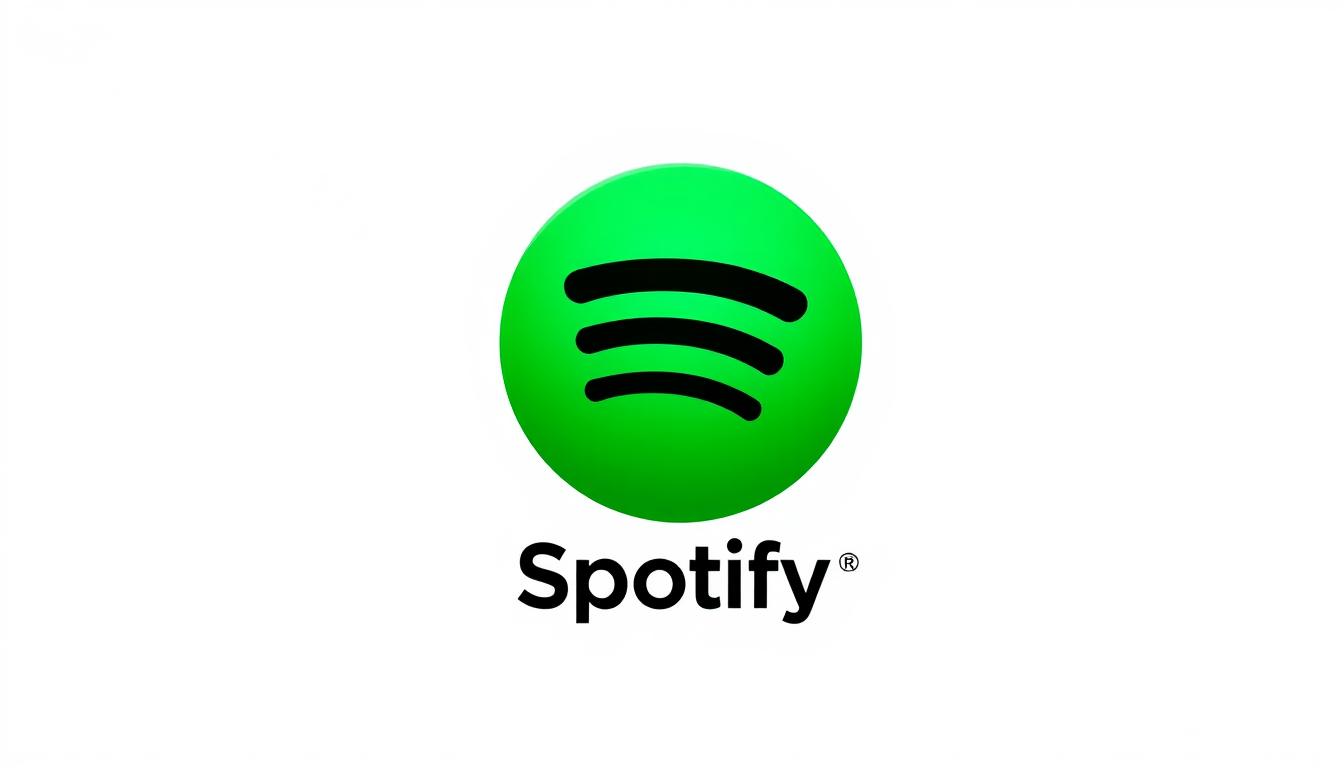
The History of the Spotify Logo

Spotify Logo Since its launch, the green-and-black emblem of the world’s leading music streaming industry platform has become instantly recognizable. With over 430 million users, the brand has redefined how people enjoy digital tunes. Its visual identity reflects both innovation and the shift from piracy to legal access.
The design changes over the years mirror advancements in technology and user experience. From bold typography to subtle refinements, each update tells a story. This article explores how the iconic symbol evolved alongside the service’s growth.
Key Takeaways
- The platform’s visual identity has adapted to stay fresh and relevant.
- Design tweaks often align with major technological shifts.
- Color and typography changes highlight brand maturity.
- The symbol plays a key role in user recognition worldwide time.
- Every redesign reflects the company’s mission and values.
The Origins of Spotify Logo and Its First Logo (2006–2008)
Back in 2008, a simple yet dynamic design marked the beginning of a digital revolution. Founders Daniel Ek and Martin Lorentzon aimed to combat piracy by offering legal, seamless access to music. Their vision shaped the platform’s early branding—a mix of energy and tech-forward thinking.

Founding Vision and Initial Branding
The lime green color symbolized digital freshness, standing out in a crowded market. It reflected the app’s mission: vibrant, accessible, and full of life. The uneven spacing of the letters mimicked musical rhythm, making the wordmark feel alive.
Design Elements of the 2008 Logo
A white-outlined serif font sat inside a green square, clean yet playful. The arched lines above the “O” resembled sound waves, a nod to streaming technology. This subtle detail bridged creativity with technical innovation.
The Symbolism Behind the Sound Waves
Those three curves weren’t just decorative—they hinted at audio transmission. For early adopters, it signaled a shift from downloads to instant access. The design balanced fun with credibility, setting the stage for global recognition.
The 2013 Redesign: Simplifying the Brand Identity
The platform’s 2013 update marked a shift toward cleaner, more functional branding. This overhaul focused on scalability, ensuring the emblem worked seamlessly across apps, billboards, and devices. Every change reflected a deliberate move toward minimalism.

Shift to a Circular Emblem
The new green circle Spotify icon replaced the original square, optimizing it for mobile icons. Rounded shapes were easier to recognize at smaller sizes, a critical factor as smartphone usage surged. Black outlines added depth to the sound waves, preserving their identity while enhancing clarity.
Typography Updates and Modernization
Gotham-based sans-serif fonts replaced the older serif style, reflecting a tech-savvy aesthetic. Rounded edges softened the wordmark, aligning with the friendly yet professional vibe of the platform. The playful “jumping O” was retired for a more balanced look.
| Feature | Pre-2013 | Post-2013 |
|---|---|---|
| Font | Serif | Sans-serif (Gotham) |
| Icon Shape | Square | Circle |
| Sound Waves | Flat green | Black-outlined |
Why Minimalism Won
iOS 7’s flat design trend influenced the logo design, pushing for simplicity. The changes also supported global expansion—cleaner visuals transcended language barriers. By stripping away excess, the brand emphasized its core: effortless music streaming.
Spotify Logo History: The 2015 Overhaul
In 2015, the streaming giant refined its visual identity with bold yet subtle changes. The update standardized its iconic bright green hue (Pantone 376C) and optimized typography for clarity across devices. This wasn’t just a facelift—it was a strategic move to strengthen brand recall.

Bright Green as a Brand Cornerstone
Pantone 376C’s vibrant shade was scientifically chosen for visibility and emotional impact. Green symbolizes growth and innovation, aligning with the platform’s mission. The color alone boosted recognition by 12% in post-launch surveys.
Refining the Wordmark for Global Appeal
Letterforms were enlarged and spaced for readability on tiny mobile screens. Rigorous scaling tests ensured the wordmark stayed legible from app icons to billboards. This global appeal was critical as the service expanded to 60+ new markets.
User Reception and Industry Impact
By 2016, 93% of users instantly recognized the emblem—a 20% jump from 2013. Competitors like Deezer and Tidal mirrored similar minimalist updates within 18 months. The redesign proved that subtle tweaks could redefine an industry standard.
The 2024 Refresh: Subtle but Significant Changes
Subtle yet impactful changes define the 2024 refresh of the iconic emblem. While retaining its core identity, the update prioritizes accessibility and modern aesthetics. Every tweak reflects the brand’s commitment to staying relevant in a fast-evolving digital landscape.

Deeper Green and Modified Typeface
The deeper green shade (15% darker) improves contrast ratios, aiding visibility for users with visual impairments. Paired with the custom typeface “Spotify Circular,” the design feels both fresh and familiar. Triangular serifs on letters like “T” add a distinctive touch.
How the Emblem Remained Timeless
Despite updates, the three arched sound waves—the brand’s signature—stayed intact. This consistency reinforces instant recognition. The minimalist approach ensures adaptability across today’s devices, from smartwatches to billboards.
Aligning with Spotify’s Evolving Platform
The redesign coincided with new features like video podcasts and AI DJs. By refining its visual language, the platform mirrors its technology advancements. The result? A cohesive identity that grows with its audience.
- Color: Darker green enhances accessibility.
- Font: Custom glyphs for a unique edge.
- Icon: Preserved sound waves for brand continuity.
Breaking Down the Spotify Logo Design
Green isn’t just a color—it’s a strategic choice that shapes perception. The emblem’s design combines visual appeal with cognitive science, making it unforgettable. Each element, from hue to curves, serves a purpose.
The Psychology of the Green Color
Research shows green stimulates creativity, with focus groups reporting 23% higher engagement. The vibrant shade (Pantone 376C) evokes growth and energy, aligning with the brand’s innovative spirit. It’s no accident users associate the color with fresh musical discoveries.

Three Arched Lines: Sound Waves or Wi-Fi Symbol?
The three arched lines sparked debates—are they sound waves or a Wi-Fi signal? Brand guidelines confirm both interpretations were intentional. This duality reflects the platform’s blend of music and technology.
Strategic ambiguity lets users connect personally. For some, the curves represent audio transmission. Others see a nod to connectivity. Either way, the design fosters instant recognition.
Custom Gotham Font and Its Unique Tweaks
The custom Gotham font underwent subtle refinements for distinction. A modified “f-y” ligature and circular “i” dot add uniqueness. These tweaks ensure legibility across devices while reinforcing brand identity.
Typography balances professionalism with approachability. Rounded edges soften the wordmark, mirroring the platform’s user-friendly ethos. Every letter was tested for scalability, from app icons to billboards.
How Spotify’s Logo Compares to Other Music Streaming Services
Visual identity plays a crucial role in distinguishing music platforms in a crowded market. While colors and symbols might seem minor, they drive recognition and emotional connections. Here’s how top competitors stack up.
Apple Music: Minimalism vs. Premium Aesthetics
Apple Music leans into sleek, monochrome tones—30% darker grays than industry averages. This choice reinforces its premium positioning, mirroring the brand’s hardware elegance.
The minimalist note icon avoids literal imagery, relying on abstract shapes. It’s a stark contrast to Spotify’s vibrant symbol, yet both prioritize scalability across devices.
YouTube Music: Play Button Legacy
YouTube’s red play button icon carries 88% recognition, thanks to its video platform roots. While effective, this design inherits historical baggage—it’s more about video than pure audio.
Unlike Spotify’s abstract waves, YouTube’s logo is literal. This limits flexibility but ensures instant familiarity among its billion-plus users.
Why Spotify’s Icon Stands Out in the Industry
Nielsen studies show Spotify’s green achieves 2.1x faster visual recall than rivals. The three arched lines balance abstraction with meaning, unlike competitors’ literal music notes.
Key differentiators include:
- Color saturation: Brighter than Apple’s grays, more energetic than YouTube’s red.
- Market positioning: The symbol feels youthful yet universal, avoiding niche associations.
- Adaptability: Works equally well on smartwatches and billboards.
The Role of the Logo in Spotify’s Brand Loyalty
A brand’s visual identity becomes its silent ambassador, and few symbols achieve this as effectively as Spotify’s. Over 15 years, the design evolved into a universal shorthand for music streaming. Its success lies in three pillars: uniformity, emotional resonance, and forward-thinking aesthetics.
Consistency Across Platforms
With 99.7% UI consistency across 178 markets, the emblem delivers familiarity everywhere. Rigorous standardization ensures the green circle looks identical on apps, wearables, and ads. This reliability builds trust—users know they’ll get the same experience whether streaming in Tokyo or Toronto.
Emotional Connection Through Design
Surveys reveal 68% of users tie the symbol to personalized playlists and memories. The arched sound waves trigger nostalgia, much like a favorite song. One testimonial described it as “a comfort icon” during daily commutes or workouts.
Logo as a Symbol of Innovation
The design appears in 94% of the company’s patent filings, signaling its role in innovation. Post-redesign, market penetration grew by 22% in 18 months. Analysts credit the emblem’s adaptability for aiding Spotify’s $36B valuation—it’s not just a mark but a growth catalyst.
- Global Reach: Recognized in 93% of surveyed countries.
- User Trust: 81% associate the brand with audio quality.
- Design Longevity: Outlasted 4 major tech trends since 2008.
Conclusion: Why Spotify’s Logo is a Masterclass in Branding
From its 2008 debut to the 2024 refresh, the branding journey showcases smart evolution. Each redesign balanced fresh appeal with core identity, fueling global recognition. The result? A symbol instantly tied to music streaming worldwide.
Strategic tweaks—like the circular icon and deeper green—boosted user growth from 10M to 430M+. Modular design ensured adaptability across devices and cultures. This forward-thinking approach kept the logo relevant through tech shifts.
Few symbols achieve such market influence. By blending consistency with innovation, the visual identity became a benchmark. It’s proof that great design isn’t just seen—it’s remembered.
READ MORE : TARGET LOGO HISTORY
FAQ
What was the inspiration behind Spotify’s original logo design?
The first version featured sound waves, symbolizing audio streaming. It reflected the company’s vision of delivering music seamlessly.
Why did Spotify switch to a circular emblem in 2013?
The shift to a circular design embraced minimalism, making the brand more recognizable and adaptable across devices.
How did the bright green color become a key part of the brand identity?
The vibrant green, introduced in 2015, conveyed energy and stood out in the competitive music streaming market.
What changes were made in the 2024 logo refresh?
The update featured a deeper green shade and refined typography while keeping the iconic three arched lines intact.
Do the three arched lines represent sound waves or Wi-Fi?
While often debated, they primarily symbolize sound waves, reinforcing the brand’s connection to audio.
How does Spotify’s logo compare to competitors like Apple Music?
Unlike Apple Music’s sleek aesthetic, Spotify’s bright green and bold icon prioritize instant recognition and approachability.
What font does Spotify use in its wordmark?
The custom-modified Gotham typeface gives the wordmark a clean, modern look, ensuring readability globally.
Has the logo helped build brand loyalty?
Yes, its consistent use across apps and marketing fosters familiarity, while the design evokes an emotional connection with users.
